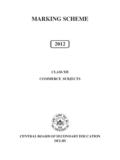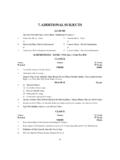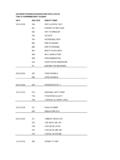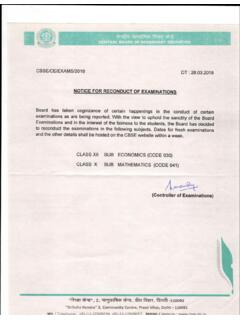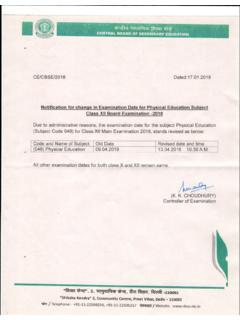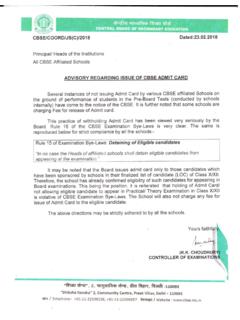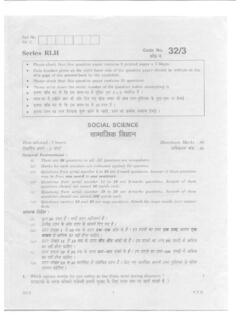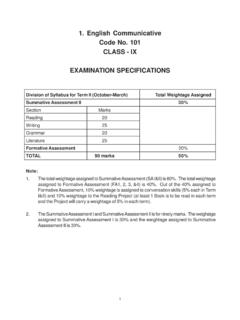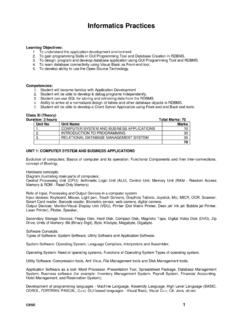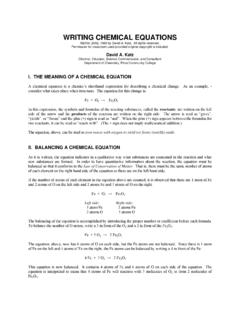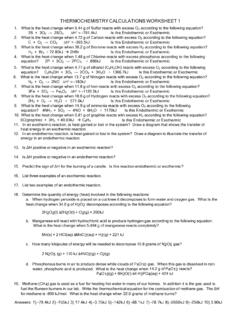Transcription of Metals and Non-metals Chapter 3 - CBSE
1 31 Formative Assessment Manual for Teachers Metals and Non- Metals - Chapter 3 c. What is the brown flaky substance? d. What are the common valencies shown by metal M ?Suggested Remediation: Some students may find it difficult to remember various reactions and properties of Metals , their compounds and gases evolved during reactions of the carbonates and sulphide ores with dilute acids. They may be encouraged to tabulate various reactions of Metals in general form and be familiar with all the reactions. Revisiting Chapter 1 Chemical Reactions and Equations may be required for students who find it difficult to write balanced chemical reactions. Attention of the students may be drawn towards categorising the reactions into various types studied in Chapter and Non- Metals Chapter 3 Assessment Technique: Multiple Choice Questions Based WorksheetObjectives: To enable students to- Recall various physical and chemical properties of Metals and non- Metals .
2 Draw correlation between the oxide of an element and pH of its aqueous solution. Recall reactivity series of Metals to predict the products of a reaction. Apply the conceptual knowledge to daily uses of the : Individual Procedure:The students may be given the following MCQ based worksheet after the teaching-learning of the complete unit Metals and Non- Metals to strengthen the Parameters: Each of the following questions may be assessed giving equal weightage of 1 mark to each correct Worksheet: Time: 30 minutesChoose the most current in each of the following : 1. Ail the following materials show property of malleability except a. Iron b. Graphite c. Aluminium d. Silver32 Chapter 3 - Metals and Non- Metals Formative Assessment Manual for Teachers2. The solution of ash obtained after burning magnesium ribbon in air will turn.
3 A. Red litmus to blue because it is acidic in nature. b. Blue litmus to red because it is basic in nature. c. blue litmus to red because if is acidic in nature. d. Red litmus to blue because it is basic in ___x____is the product formed when sulphur reacts with oxygen, it dissolves in water to produce ___y___ Choose correcl oplion for x and Sodium metal is stored in ___x___ because it reacts vigoursly to produce ___y___ Choose the correct option for x and oxidebAlcoholNeutral oxidecKeroseneBasic oxidedAir tight containerAcidic carbonate5. metal ___x___ reacts vigorously with water to produce gas__y__which burns with the pop sound Choose the correct option for x and oxide33 Formative Assessment Manual for Teachers Metals and Non- Metals - Chapter 36. Which of the following can be beaten into thin sheets?
4 A. Zinc b. Phosphorus c. Sulphur d. Oxygen7. Read the following statements carefully and select the correct statements about the physical and chemical properties of Metals - I. All Metals are ductile II. Generally Metals are ductile III. Metals which are more reactive than hydrogen react with acids to release hydrogen gas. IV. All Metals react with acids to release hydrogen gas. The correct statement of the above are- a) 1 and IV b) I and III, c) II and III d) II and IV8. Aluminium foil is used for wrapping food because- a. It is ductile b. It is malleable c. It is a good conductor of heat d. It is sonorous9. What happens when dilute sulphuric acid is poured on a copper plate? a. No reaction takes place b.
5 Zinc sulphate formed c. Copper chloride formed d. Copper sulphate Which material is hard in nature? a. Iron b. Graphite c. Oxygen d. sodium11. Which one of the following metal is used in thermo meters? a. Copper b. Mercury c. Aluminium d. Iron12. Correct the statement by substituting the x and y with correct option. X can t be drawn into wires because it is not Y in 3 - Metals and Non- Metals Formative Assessment Manual for Teachers13. Zinc replaces copper from _X__ solution because it is __Y___than copper. Substitute X and Y with correct sulphateLess reactivebCopper sulphatemore reactivecsulphuric acidmore reactivedCopper sulphateLess reactive14. Most metallic oxides are- a. Acidic is nature b. Neutral in nature c. Basic in nature d.
6 Amphoteric in nature15. ___X___is used for decorating sweets because it is_Y___ in nature? Substitute X and Y with correct foilDuctilebCopper foilMalleablecAluminium foilDuctiledSilver foilMalleableSuggested Remediation: Some students may find it difficult to remember difference between ductility and malleability Spending time on and 15 will help remove this difficulty. More over some mnemonic may be given to the students eg. Drawn into wires-Ductility. Some students may find it difficult to comprehend the difference between the sentences- all Metals and generally most Metals have the property teacher should help them in understanding the difference. This worksheet should be able to help diagnose any difficulties in the understanding of the concepts of physical and chemical properties of Metals and Assessment Manual for Teachers Carbon and its Compounds - Chapter 4 Carbon and its Compounds Chapter 4 Assessment technique: Content based worksheetObjectives: To enable students to-: Learn that ethyl alcohol is a major component of wine.
7 Learn that vinegar is 5-8 % solution of ethanoic acid. Understand that ethanol is oxidized to ethanoic acid on heating with Alkaline KMnO4 or acidified Potassium dichromate. To correlate the given facts about an organic compound to solve a problem identification of unknown compoundTask: IndividualProc:edure: The following worksheet may be given to the students after a teaching-learning episode on chemical and physical properties of ethanol and may give the following information to the students as a recall before giving them the worksheet - CH3CH2OH is a major component of wine. Alcohols on oxidation with Alkaline KMnO4 or acidified Potassium dichromate are converted to carboxylic acids. Example: CH3CH2OH CH3 COOH Vinegar is 5-8% solution of ethanoic acid, it is widely used as a preservative in Worksheet Time = 10 minStudy the given problem carefully and answer the following questions:Problem-An organic compound A (C2H4O2) is a constituent of wine.
8 This compound, on heating with alkaline potassium permanganate gets oxidised to, give, another compound B which turns blue litmus Identify compound A. Write down its chemical name and chemical formula. Chemical name_____ Chemical formula_____36 Chapter 4 - Carbon and its Compounds Formative Assessment Manual for TeachersQ2. Identify compound B. Write down its chemical name and its chemical formula. Chemical name_____ Chemical formula_____Q3. Identify the functional groups in the compounds A and Write the chemical equation for. the reaction of A with alkaline KMnO4 to produce Name the type of reaction that takes place for formation of B from What is the nature of compound B?Q7. What is 5-8 % solution of B in water called?Suggested Remediation: Some students may not be able to identify the compounds in the given problem.
9 Help them recall the properties of the organic compounds in the 10th std syllabus. Encourage the students to make a table of properties of all the organic compounds in their course. Some students may find it difficult to write the chemical formula or identify the functional groups of the compounds they may be helped by giving some extra task of solving problems, writing the formula and identification of the functional group. Teacher may take up a quiz in the class where one group poses the question and other and its Compounds Chapter 4 Assessment technique: Demonstration based worksheetObjectives: To enable students to Understand that alcohols and carboxylic acid react in presence of an acid catalyst to form esters and the reaction is known as etherification reaction.
10 Learn that esters are sweet smelling compounds and are used in making perfumes and flavouring Assessment Manual for Teachers Carbon and its Compounds - Chapter 4 Enhance their observation skill. Correlate the occurrence of a chemical reaction to the evolution of sweet : IndividualProcedure:Teachers may perform activity no. on page 73, of class X NCERT Science textbook and may explain that Alcohols and carboxylic acid react in presence of acid catalyst to form esters and the reaction is known as etherification. The chemical reaction involved in the process is- CH3 COOH + CH3CH2OH CH3 COOC2H5 The mixture is to be heated in a water bath as alcohol is inflammable. Esters are sweet smelling compounds and are used in making perfumes and flavouring criteria The teacher may mark the answers to the questions given in the worksheet by keeping a weight age of 2 marks each for Q.
